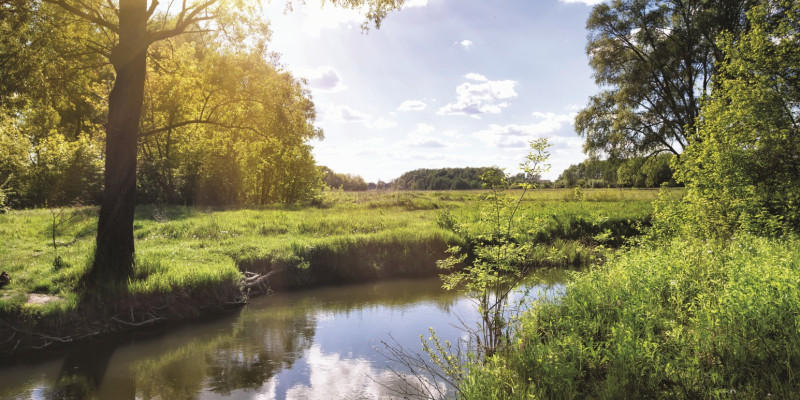RO-R-2: Priority and reserved areas groundwater / drinking water
 Click to enlarge
Click to enlargeSource: Photograph: © alexlukin / stock.adobe.com

2019 Monitoring Report on the German Strategy for Adaptation to Climate Change
 Umweltbundesamt
Umweltbundesamt
 Click to enlarge
Click to enlarge
2019 Monitoring Report on the German Strategy for Adaptation to Climate Change
In the process of redesigning individual regional plans over recent years, priority and restricted areas were in many cases either not renewed or designations were limited to a rather smaller spatial extent. Consequently, by 2009 the terrain of spatial planning areas dedicated to the conservation of drinking water and groundwater had declined.

A line represents the area of the priority and reserved areas for groundwater protection / drinking water abstraction in the form of indexed values. The year 2009 is set to 100. There is a significant downward trend until 2017. In addition, the percentages of the planning regions with priority and reserved areas for groundwater protection / drinking water abstraction are shown in a row of columns. Here, too, there is a significant downward trend. The values range around 80 percent.
Although Germany is a water-rich country with, generally speaking, adequate availability of water, there are some regions in which there are localised areas with water shortages where usable groundwater resources are scarce and where in some seasons the demand for water cannot always be met from resources within the region. In those regions distribution systems are used to balance regional differences in the availability of water. Climate change may further worsen the currently already unfavourable climatic water regime in some regions of Germany. Changed precipitation and temperature conditions affect all processes occurring in the water regime thus influencing also the formation of groundwater recharge rates as well as the amount and quality of groundwater and surface waters used for the abstraction of drinking water. Increasing water shortages and more frequent droughts may give rise to regional conflicts in particular regarding the use of water resources near the surface.
Planning at state and regional level can designate priority and restricted areas for the conservation of drinking water and groundwater, thus safeguarding water resources by means of planning measures, moderating between diverging claims on land use and avoiding or mitigating conflicts. Just under 80% of planning regions avail themselves of this opportunity. The high proportion of planning regions which carry out designations demonstrates that spatial planning tools are not just used in planning regions affected by water shortages. In fact, the protection and safeguarding of water resources is of major importance also in water-rich areas, partly because their water resources are in part used for provisioning water-poor areas.
To what extent various area categories are implemented for the conservation of groundwater and drinking water in individual planning regions depends above all – apart from variations in planning practice – on the individual spatial character of regions, such as soil properties and geological baseline conditions, for instance whether the vegetation is near-natural and the intensity of its use. In 2017 an overall terrain of approximately 39,000 square kilometres in Germany was designated as priority or restricted areas for the conservation of drinking water and groundwater – the equivalent of more than 10 % of the total land of the Federal Republic. Even though the areal expansion does not provide any direct conclusions on whether areas are designated to the appropriate spatial extent or quality, this percentage does illustrate the great importance attached to the conservation of water resources in spatial planning terms.
As a rule, regional plans are redesigned or updated every ten to fifteen years. In this process, planning regions may update the specifications contained in plans, which may entail changes in areal designations. Furthermore, plans may on these occasions also be adapted to changes in law or jurisdiction.
Especially in dry regions of the Federal Republic, specifications on climate-related groundwater protection have already been designed for inclusion in the updating process of spatial planning regulations. Nevertheless, the terrain designated for the conservation of water resources has declined by approximately 3,700 square kilometres since 2009. The reason for this was that spatial planning areas intended for safeguarding the supply of drinking water or for the conservation of groundwater resources were not specified again in some of the newly designed regional plans or that their areal extent was reduced.
Strengthening the safeguarding of water resources by spatial planning regulations and making increased use of planning tools for the adaptation of land use (DAS, ch. 3.2.14)
Intensified safeguarding of water resources, also and especially for the purpose of sustained, long-term safeguarding beyond current usage requirements (spare areas); support for the conservation or enhancement of the water regime of soils (increasing their water storage capacity, enhancing their infiltration capacity) in sensitive parts of groundwater catchment areas; provident governance in respect of water-based processes in areas particularly affected by drought (Handlungskonzept Klimawandel, MKRO 2013, ch. 3.5)